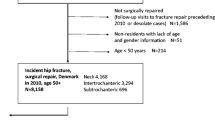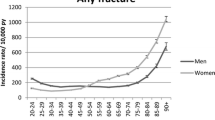Abstract
Summary
We conducted the first study to determine fracture incidence in institutionalized elderly people in East Asia. Fracture incidence was generally higher than in the general population but was not for all fracture types. Specific fracture prevention strategies for institutionalized people are needed. Ethnic differences in fracture incidence are also discussed.
Introduction
The aim of this study was to determine the incidence of fractures in nursing homes in Japan, where fracture is becoming an increasingly problematic health issue.
Methods
We conducted a cohort study with a 1-year follow-up. Subjects were 8,905 residents (average age, 84.3 years) in nursing homes. Caregivers assessed activities of daily living levels using Barthel’s index, and we collected demographic data of each resident. Fracture diagnosis was based on medical records from the hospitals where patients were admitted.
Results
Incidence of hip fracture was 14.9 per 1,000 person-years for women and 9.7 for men. Incidence of forearm and upper-arm fractures was 1.9 and 5.1 for women and 0.5 and 2.1 for men, respectively. Hip and upper-arm fracture rates were higher than in the general population, but forearm fracture rates were lower. Hazard ratio of fracture incidence in totally dependent to partially dependent or independent subjects was 0.14 (95%CI 0.05–0.33) for hip fracture and 0.34 (95%CI 0.23–0.50) for all fractures.
Conclusions
Fracture incidence in institutionalized elderly people is generally higher but is not higher for all types of fractures than the general population. In addition, totally dependent persons had a much lower risk of hip fracture.
Similar content being viewed by others
References
Magaziner J, Fredman L, Hawkes W, Hebel JR, Zimmerman S, Orwig DL, Wehren L (2003) Changes in functional status attributable to hip fracture: a comparison of hip fracture patients to community-dwelling aged. Am J Epidemiol 157:1023–1031
Health and Welfare Statistics Association (2007) Kokumin-eisei-no-doko (Health and Welfare Statistics in Japan). Health and Welfare Statistics Association, Tokyo (in Japanese)
Ota T, Harada A, Tokuda H (2002) Cost-effectiveness of hip fracture in Japan. Jpn J Geriat 39:483–488 (in Japanese)
Miravet L, Chaumet-Riffaud P, Ranstam J (1993) Residential care and risk of proximal femur fracture. Bone 14(Suppl 1):S73–S75
Ooms ME, Vlasman P, Lips P, Nauta J, Bouter LM, Valkenburg HA (1994) The incidence of hip fractures in independent and institutionalized elderly people. Osteoporos Int 4:6–10
Sugarman JR, Connell FA, Hansen A, Helgerson SD, Jessup MC, Lee H (2002) Hip fracture incidence in nursing home residents and community-dwelling older people, Washington State, 1993–1995. J Am Geriatr Soc 50:1638–1643
Garman CJ, Chandler JM, Zimmerman SI, Martin AR, Hawkes W, Hebel JR, Sloane PD, Magaziner J (2002) Prediction of fracture in nursing home residents. J Am Geriatr Soc 50:1341–1347
Ishikawa M, Nakamura K, Tamura T, Akiyama S, Tsuchiya Y (2006) Ethnic differences between Asians and Caucasians in the incidence of osteoporotic fractures: a review. Acta Med Biol 54:63–66
Mahoney FI, Barthel DW (1965) Functional evaluation: the Barthel Index. Md State Med J 14:61–65
Takigawa Y (1994) Criteria for independence of demented elderly people (authors’ translation). Koshu-Eisei (J Public Health Pract) 58:73–75 (in Japanese; English version is available at http://www.med.niigata-u.ac.jp/hyg/Dementia.pdf)
Walter LC, Lui LY, Eng C, Covinsky KE (2003) Risk of hip fracture in disabled community-living older adults. J Am Geriatr Soc 51:50–55
Morita Y, Endo N, Iga T, Tokunaga K, Ohkawa Y (2002) The incidence of cervical and trochanteric fractures of the proximal femur in 1999 in Niigata Prefecture, Japan. J Bone Miner Metab 20:311–318
Sakuma M, Endo N, Oinuma T, Endo E, Yazawa T, Watanabe K, Watanabe S (2008) Incidence and outcome of osteoporotic fractures in 2004 in Sado City, Niigata Prefecture, Japan. J Bone Miner Metab 26:373–378
Chandler JM, Zimmerman SI, Girman CJ, Martin AR, Hawkes W, Hebel JR, Sloane PD, Holder L, Magaziner J (2000) Low bone mineral density and risk of fracture in white female nursing home residents. JAMA 284:972–977
Butler M, Norton R, Lee-Joe T, Cheng A, Campbell AJ (1996) The risks of hip fracture in older people from private homes and institutions. Age Ageing 25:381–385
Sambrook PN, Cameron ID, Chen JS, Cumming RG, Lord SR, March LM, Schwarz J, Seibel MJ, Simpson JM (2007) Influence of fall related factors and bone strength on fracture risk in the frail elderly. Osteoporos Int 18:603–610
Hagino H, Yamamoto K, Ohshiro H, Nakamura T, Kishimoto H, Nose T (1999) Changing incidence of hip, distal radius, and proximal humerus fractures in Tottori Prefecture, Japan. Bone 24:265–270
Japanese Council of Senior Citizens Welfare Service (2006) Reports of the 2005 survey on basic information of the registered geriatric homes. Japanese Council of Senior Citizens Welfare Service, Tokyo (in Japanese)
Acknowledgements
We wish to thank the Niigata Council of Institutions for the Elderly for help in data collection. We also thank Drs. M. Sakuma and N. Endo for providing us with their data and Ms A. Kagoshima for help with data analysis. This study was partly supported by a grant from the Chiyoda Mutual Life Foundation, 2006.
Conflicts of interest
None.
Author information
Authors and Affiliations
Corresponding author
Rights and permissions
About this article
Cite this article
Nakamura, K., Oyama, M., Takahashi, S. et al. Fracture incidence in nursing homes in Japan. Osteoporos Int 21, 797–803 (2010). https://doi.org/10.1007/s00198-009-1015-x
Received:
Accepted:
Published:
Issue Date:
DOI: https://doi.org/10.1007/s00198-009-1015-x




